In the two-day festival will screen six video artist Tiziana Pers in the theater that hosts conferences.
slide show I see you (Sabato 11 June hours 11.50)
'Tiziana Pers in the exhibition Marinella Senatore. building Communities, set up in the Manica Lunga at Castello di Rivoli, the 19 December 2013 It conducted a performance entitled I see you in the space Movie Set. 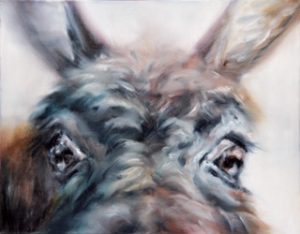
During the action performative, the Persons, a strong and statuesque Friulian artist, accompanied by a group of children, It connects via Skype with Comet, a donkey rescued by a merchant who was going to send her to the slaughter. Children are invited to dialogue with the donkey, reading of the sentences, selected by the artist and printed on sheets spread out on the ground, or to speak directly with Comet, in a protected place on the hills of Friuli, It follows with interest what is happening on the screen while eating a carrot.
The empathy between the young of the human and non-human animal is taken immediately. Tiziana has explained to them that Comet was saved from the slaughterhouse and, thanks to them at the time they are there, will live on. Not by chance, knowing that Comet was saved thanks to the generous donations and the work of activists, Tiziana told them: "Comet is alive because of you", extending to children the concept of participation and individual action.
Some children cried, some have told stories, others have heard, but there was no one who has not participated, trying, if it were needed, that in a certain moment in the life of a future man or a future woman, in a fast, transitory moment, there is the opportunity to 'put listening' animal to animal, that no human.
In his artistic practice, Tiziana applies the formula of barter to an animal for slaughter which will be exchanged for a work. His art becomes a bargaining chip, but the price of the work is not quantified in a sum of money, but with a real life. Apparently this is a fairly simple task, that subtracts the animal and the work of the usual art world and breeding mechanisms respectively while, at the same time, wonders at the same time the value of art, and on that of life. The profound meaning of this operation is, however, more than, in what remains, in the result: l'animals, that animal, is alive.
It is a process not without a lot of doubts and questions, and many provocative verses, but it looks really one of the first concrete attempts to bring together art and the animal world to a new level, timidly permeated antispeciesism, in an era, our, which can be considered as the prehistoric animal rights.
In addition to the animal's life, the fleeting moment of the performance, follow paintings in which the artist focuses his gaze on animal eyes, in two ways. Primarily, Tiziana explores anatomically animal eyes that contain the look, bringing out the subjectivity of the beings who portrays: glassy eyes of laboratory rabbits are different from those darting of his beloved horse Tor. In second place, Tiziana paints her eyes and making herself by portraying the animal other than itself out of the stereotypes that have for centuries characterized the representation animal.
Tiziana the animals are free from physical cages but, mostly, from the invisible cages that our imagination has built around them. '
Valentina Sonzogni, from 'Hospitality Exercises', published on gallinae in Fabula
At the End of the Mirror (Sabato 11 June hours 13.50)
The protagonist of the video is a white rabbit. It is an animal that I had saved from slaughter several years ago, and that I was then stolen while I was in her seventh month of pregnancy. For me and for my family was part of the family, and we have experienced a painful loss.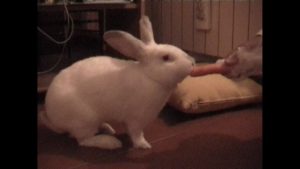
Of video clips depicting the rabbit inserted in his peaceful home environment, from which was subtracted, alternating with brief flashes of aseptic laboratories of vivisection, and ended with the shooting of a group of the Animal Liberation Front activists while rescuing rabbits ranging from enclosures of vivisection.
White Rabbit becomes the leitmotif of a double vision, where dreams and nightmare overlap, as we follow the White Rabbit from Alice in Wonderland. My personal experience is told during the video, alternating the reading of excerpts from two Lewis Carroll's masterpieces.
The lure sharp imagery Carroll (one of the precursors of the anti-vivisection) It then opens through the entrance into the rabbit hole of Alice in Wonderland and continued 'through the looking glass', come in Through the Looking-Glass and What Alice Found There, for not close if not in a vision where reality is perceived through its symmetrical.
Pandora 2 : The First Supper (Sabato 11 June hours 17.50)
In Pandora_2 I saved two horses from slaughter, then physically share a meal to which they and the audience together took part. Close to be represented as a food, considered objects, the animals are transformed into another, themselves become diners, similar in pain, while preserving the right to be different, by means of a recognition ritual. 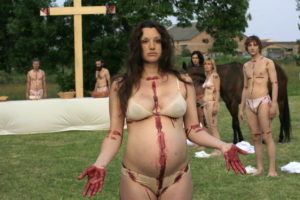
The items that were offset by reading the Canticle of the Creatures belong to some of the children who attend a pet therapy center, which subsequently it adopted one of two horses.
In the performance there is a voluntary reference to Theatre of Orgies and Mysteries di Hermann Nitsch, But that is realized for absolute contraposition. The catharsis here is done without victims, but on the contrary it arises in the act of saving empathic sharing. The action itself is the moment of initiation, that breaks down the boundaries between art and the public, prompting the need for an ethical question.
Rebirth (Sunday 12 June hours 16.50)
The video opens and closes with the image of water, place from which everything originates: the first forms of life, and ourselves, inside the uterus.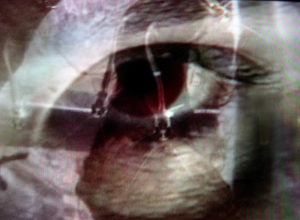
The images portray an action that had been created by the artist in the oldest shop of tropical fish in London, claustrophobic, redundant aquariums, plants and a moltitutine of small animals from around the world. Located next near Victoria Station, he was in front of where he lived Joseph Conrad, author of Heart of Darkness.
The themes of contemporary colonialism and of speciesism overlap, the claustrophobic atmosphere leads to a forced captivity. L'artista, trapped in a long fabric that blocks it and gives it the appearance of a strange hybrid creature, It refers to a small salamander, l'axolotl. Animal with unique features, in normal conditions he lives under water as a fish, and contrary to all other amphibians (born in water but then to grow and reproduce and are forced to turn to breathe with lungs) It is able to spend his whole life in this state of "larva amphibious", breathing with gills, even reproducing, like a fish, without ever becoming adult. The processing therefore can never take place.
But if circumstances induce Axolotl at any time can implement the metamorphosis: loses its gills, molting skin texture, the tail changes appearance, become a land animal, but it is no longer able to implement the inverse procedure. The transformation is irreversible.
The uniqueness of this animal is given also by its ability to regenerate completely amputated parts of the body, like the limbs.
Revered as a god by the Aztecs, It is still the subject of many scientific studies.
The water and air elements alternate throughout the video, while life in the store proceeds indifferent.
In your tiny eyes (Sunday 12 June hours 17.50)
The project, In your tiny Eyes, developed in collaboration with Animalisti FVG, It is a video consisting of two drawings that alternate slowly dissolving the one into the.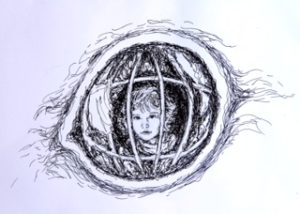
The first drawing depicts the open eye of a child, in whose reflection we see the bars of the cage. Gaze through the bars of a blackbird meets with that of the child and, of reflection, He come to us.
The second drawing depicts the eye instead of a blackbird, in reverb we read the cage. Through the same bars the child's gaze intersects with that of the blackbird, e, quindi, with our.
We viewers we, from time to time, Blackbird and child. What remains are only fixed bars.
Often in social mechanisms the details are likely to be relegated to the background, becoming the most neglected aspects. Yet in many cases is to be found in the little that the interpretations of our everyday shorts. To recognize the roots of violence sometimes is enough to dwell on what is in front of us, of what lies within the recurrence of gestures and habits.
The idea to enlarge a detail of proportion, giving monumentality intimate gesture drawing, It promises to be a window and a lens of the eye that often we do not recognize in their fullness, but we identify hastily in patina of clichés: the bird is in the cage, the child goes to see the little bird.
But if we put them in focus, if sfaldiamo the past gangrene of customary, we can then support the weight of the double gaze that speaks directly to each of us?
The look par excellence is the first form of nonverbal communication, understanding of 'other before the words.
But what of the child and the bird, enlarged and focused, It is the impossible dialogue between two innocent, as it mediated by the violence of a cage.
Elephant Song (Sunday 12 June hours 19.50)
It 'a video set in the Natural History Museum in Trieste, between the artist's works on display for the exhibition Elephant Song (March April 2016). 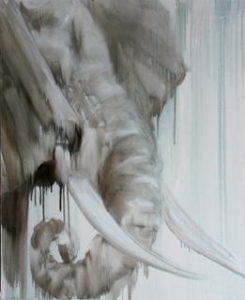
La poesia no accompagna il video of Natalia Molebatsi, one of the greatest voices of the poetry of the post-apartheid South Africa.
The music I feel the tides It is Sasha Vinci and Vincent Migliorisi, scliclitani artists composing resumed paintings, and while they worked from their sea, that physically divides Sicily from Africa elephant, and it remains the scene of immense human tragedies.
Elephant Song faces the risk of extinction of African elephants, expected by 2015 if the poaching continues with current rates, and it opens up a range of perspectives on the connections between colonialism, racism, speciesism and all forms of discrimination based on interpreted as a right strength, and violence as a result.
poaching (of ivory tusks but also other exotic and rare animals) financing international terrorism, so that the death of an animal returns as the death of a human being. We know for sure for example that the attacks in Kenya were funded from ivory.
On display there were also paintings of other animals at risk of extinction, but each frame is not imagined as a representative of a species, but as a portrait of the individual subject.
It all started with two questions that the artist has set: 'Animals I've met in a long journey in the Serengeti are still alive, or they have been killed?
And then: my son will really live in a world without elephants?’
This was the starting point of a series of further questions, which affect not only the relationship between man and animal, but also, more generally, the domain reports. And the future of many species, including our.
Leave a Reply